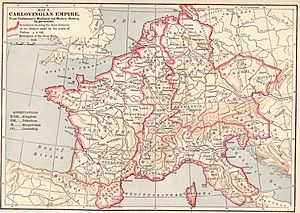Treaty of Verdun facts for kids
The Treaty of Verdun was an important agreement made in 843. It happened about two generations after the famous emperor Charlemagne died. This treaty split his large empire into three separate kingdoms.
When Charlemagne's son, Louis the Pious, passed away in 840, his oldest son, Lothair I, believed he should rule over his younger brothers and all their lands. However, his brothers, Louis the German and Charles the Bald, disagreed. They fought against Lothair and won a big battle called the Battle of Fontenay (841). This victory forced Lothair to negotiate, leading to the Treaty of Verdun.
Splitting the Empire
Before the treaty, each brother already had a kingdom. Lothair ruled in Italy, Louis the German in Bavaria, and Charles the Bald in Aquitaine. The Treaty of Verdun officially divided the rest of the empire among them:
- Lothair's Middle Kingdom: Lothair received the central part of the empire. This long strip of land stretched from the North Sea all the way down to Italy. It included areas that later became the Low Countries (like modern-day Belgium and the Netherlands), Lorraine, Alsace, Burgundy, Provence, and Italy. This kingdom was often called Middle Francia.
- Louis the German's East Francia: Louis the German received the eastern part of the empire. This area included all lands to the east of the Rhine River and to the north and east of Italy. This region eventually grew into what was known as the Holy Roman Empire during the Middle Ages. Parts of it later became modern Germany.
- Charles the Bald's West Francia: Charles the Bald received the western part of the empire. This territory later developed into modern France.
This treaty was a major event because it laid the groundwork for the future countries of France and Germany. It also showed how Charlemagne's once-united empire began to break apart.
More to Explore
- In Spanish: Tratado de Verdún para niños


